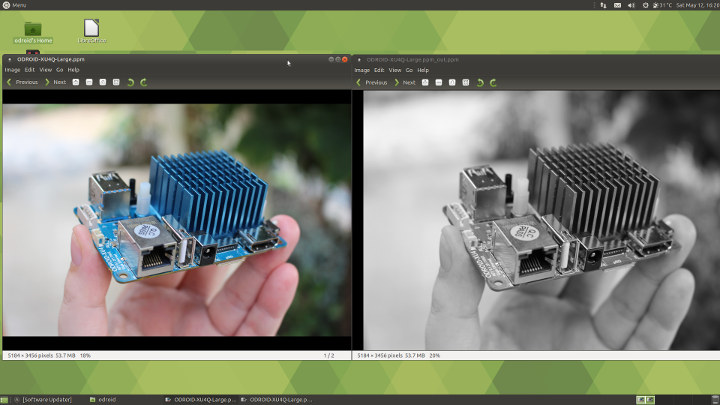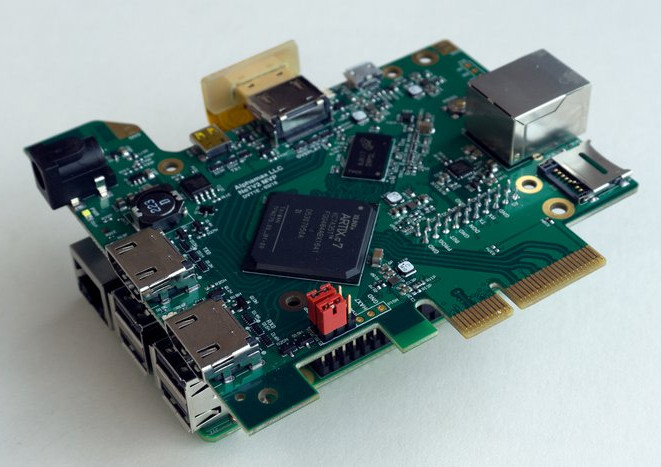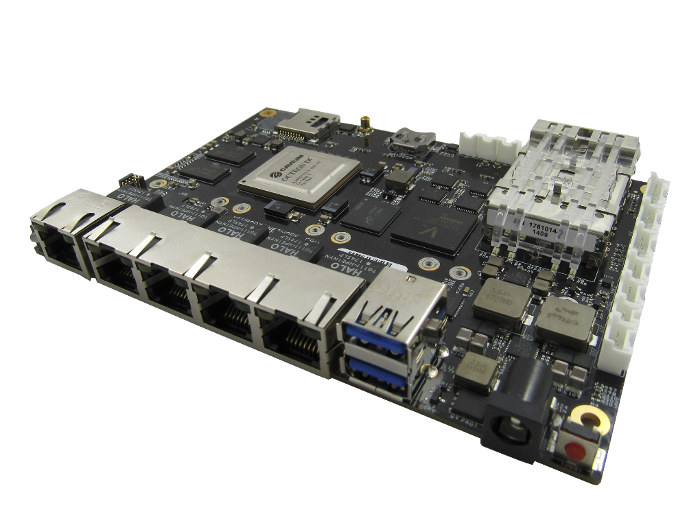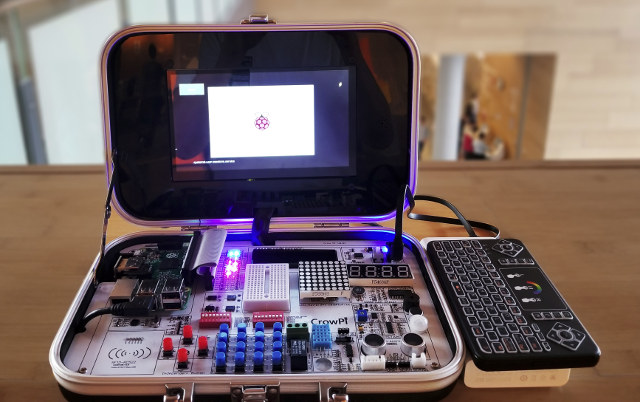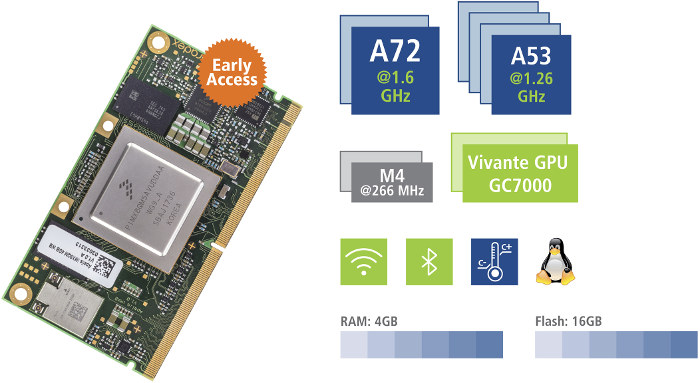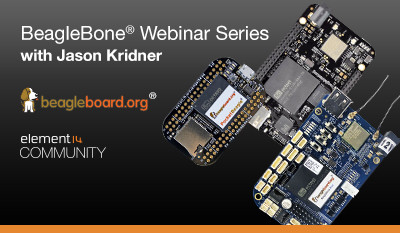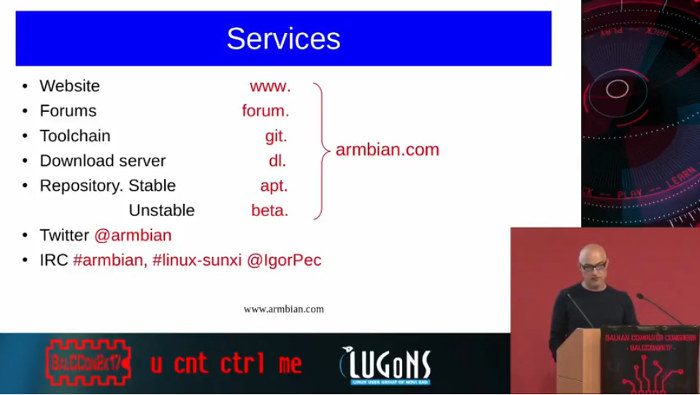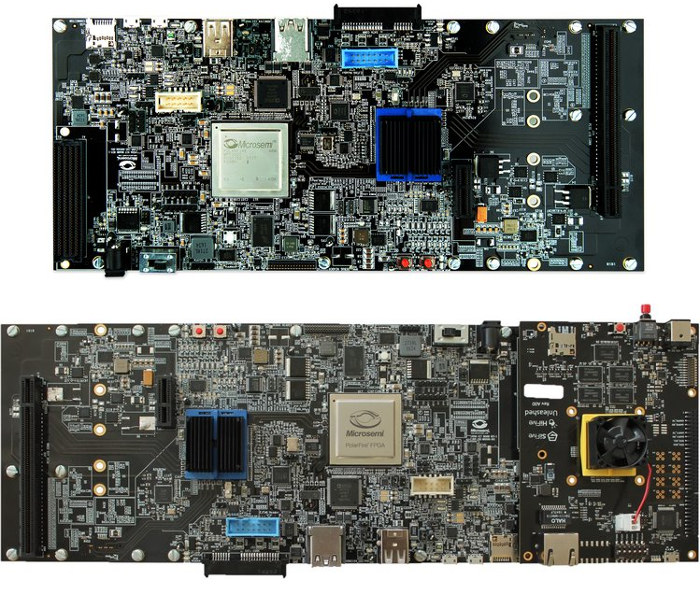Last week, I reviewed Ubuntu 18.04 on ODROID-XU4 board testing most of the advertised features. However I skipped on the features listed in the Changelog: GPU hardware acceleration via OpenGL ES 3.1 and OpenCL 1.2 drivers for Mali T628MP6 GPU While I tested OpenGL ES with tools like glmark2-es2 and es2gears, as well as WebGL demos in Chromium, I did not test OpenCL, since I’m not that familiar with it, except it’s used for GPGPU (General Purpose GPU) to accelerate tasks like image/audio processing. That was a good excuse to learn a bit more, try it out on the board, and write a short guide to get started with OpenGL on hardware with Arm Mali GPU. The purpose of this tutorial is to show how to run an OpenCL sample, and OpenCL utility, and I won’t go into the nitty gritty of OpenCL code. If you want to learn more […]
NeTV2 Open Video Development Board Works with Encrypted and Unencrypted Video Streams (Crowdfunding)
Chumby NeTV was an open source hardware Linux IPTV media player based on a Xilinx Spartan FPGA and a Marvell Armada 166 processor, and unveiled in 2011. Many years have passed since then, and now Bunnie Huang has come up with a new version. The NeTV2 development board is also optimized for open digital video application, but based on a more powerful Xilinx Artik-7 FPGA, and a Raspberry Pi 3 B+ can be added for things like seamless JTAG configuration and overlay video generation. Key features and specifications: FPGA – Xilinx Artik-7 XC7A35T-2FGG484 (available with XC7A50T option during campaign only) System Memory – 512 MB RAM, 32-bit wide DDR3-800 Storage – micro SD card, 8 MB SPI flash Video Ports 2x HDMI type A inputs 1 x HDMI type A output 1 x HDMI type D output. One input/output pair configured for in-line ‘NeTV mode’ video filtering. Max Video Bandwidth […]
Newport GW6400/GW6404 Arm SBC Comes with 5 Gigabit Ethernet Ports, 2 SFP Fiber Ports, and 4 mPCIe Sockets
Gateworks introduced their Newport SBC family based on Cavium Octeon TX Dual/Quad Core Arm processors at the end of last year, and the company has now announced the availability of the higher end models of their networking single board computers with Newport GW6400 & GW6404, which provide four mPCIe sockets for expansion, five Gigabit Ethernet ports, and in the case of GW6404, two optional SFP cages for fiber connections. GW6400 / GW6404 specifications: SoC GW6400 – Cavium OcteonTX CN8120 dual core processor up to 800MHz GW6404 – Cavium OcteonTX CN8130 quad core processor up to 1.5 GHz System Memory GW6400 – 1 GB DDR4 DRAM GW6404 – 2 GB DDR4 DRAM Storage – 8 GB eMMC Flash , micro SD card slot, serial configuration EEPROM Connectivity 5x GbE Ethernet ports GW6404 – Up to 2x optional SFP fiber ports (redirect of one or two of the RJ45 ports to SFP […]
CrowPi is a Portable Learning Kit for Raspberry Pi 3 B+ / Zero Boards (Crowdfunding)
We have an embarrassment of choices for Raspberry Pi accessories from touchscreen displays, HAT add-ons boards, sensors, breadboard, and so on, as well as good software and support from Raspberry Pi forums. This is all good, but it can be messy with all those jumper cables, and not really portable. Elecrow has a neat solution with the CrowPi learning kit for Raspberry Pi 3 and Raspberry Pi Zero that come with a 7″ display, several sensors, buttons, a breadboard, and more all packed in a small suitcase. Main parts of the kit: 7″ touchscreen display Breadboard with GPIOs status LEDs Input modules – Light sensor, IR receiver, PIR motion sensor, sound sensor, temperature & humidity sensor, touch sensor, ultrasonic sensor, NFC reader, and tilt sensor Output modules – 8×8 LED matrix, 4-digit LED display, I2C LCD1602 display, buzzer, vibration motor, relay module, 9G servo, and stepper motor. Control modules – […]
Toradex Launches Apalis iMX8 Computer-on-Module based on NXP i.MX 8QuadMax SoC
Toradex Apalis iMX8 is another system-on-module powered by NXP i.MX 8QuadMax hexa core Arm Cortex A72 + 53 processor, which comes with 4GB LPDDR4 RAM, up to 16GB flash, and an on-board dual-band 802.11ac 2×2 MU-MIMO Wi-Fi and Bluetooth 5 ready module. The company has just opened early access for selected customers, so it has become possible to start developing products with the MXM3 computer-on-module. Apalix i.MX8 module specifications: SoC – NXP i.MX 8QuadMax hexa core processor with 2x Arm Cortex-A72 cores @ 1.6 GHz, 4x Arm Cortex-A53 cores @ 1.26 GHz, 2x Cortex-M4 real-time core @ 266 MHz, and dual Vivante GC7000XSVX GPU System Memory – 4GB LPDDR4 (64 Bit) Storage – Up to 16GB eMMC flash On-module Connectivity Gigabit Ethernet via Microchip KSZ9031 transceiver with low power features Dual-band 802.11ac 2×2 MU-MIMO Wi-Fi and Bluetooth 5 via Azurewave AW-CM276NF M.2 1216 LGA module Audio – NXP SGTL5000 low […]
A 6-Part BeagleBone Webinar for Users, Developers and Education Starts on May 10
The BeagleBone Black and derivatives like PocketBeagle or BeagleBone Green Wireless are still popular development boards, and if you are interested in the platform as a developer, user, or educator, you may learn more about the boards and how to use them in an upcoming BeagleBone webinar series presented by Jason Kridner, the co-founder and board member at BeagleBoard.org Foundation, and element14. The webinar series will start in about 2 weeks with the following schedule: Introduction to BeagleBone – 10th May 2018 @ 11:00 AM (CDT)/17:00 (GMT) BeagleBone for Linux Users – 24th May 2018 @ 11:00 AM (CDT)/17:00 (GMT) BeagleBone for Embedded Developers – 6th June 2018 @ 11:00 AM (CDT)/17:00 (GMT) BeagleBone for Web Developers – 21th June 2018 @ 11:00 AM (CDT)/17:00 (GMT) BeagleBone Blue for Robotics – 12th July 2018 @ 11:00 AM (CDT)/17:00 (GMT) BeagleBone in the Classroom – 26th July 2018 @ 11:00 AM […]
Armbian History, Infrastructure, and Progress Report
Many of us rely on Armbian Debian and Ubuntu images for our cheap Arm development boards since they usually offer better support than vendor supplied firmware images. The community has just updated Armbian website, but the thing that caught my eye in the announcement was a link to a 45-minute presentation by Igor Pečovnik, working full-time on the project, that details the history about Armbian, and provides a relatively recent progress update as it was made at BalCCon – Balkan Computer Congress in November 2017. I’ve embedded the video further below, but first I’ll provide summary of the key point made during the presentation. It all started with Cubieboard (A20) as Igor was trying to fix some issues, and learn how to improve software support on the board. Several people joined his efforts on Cubieboard forums, and eventually Armbian website launched in mid 2014 running on the Cubieboard then ODROID-XU4 […]
HiFive Unleashed RISC-V Linux Development Board Gets a $2000 FPGA Expansion Board
If you’re a RISC-V architecture’s enthusiast or represent a company working on products with the new ISA, you may have spent $999 or more on Hifive Unleashed RISC-V Linux development board a few months ago. You now have the opportunity to spend an extra $1,999 for HiFive Unleashed Expansion Board powered by a MicroSemi PolarFire FPGA programmed with a PCIe root port bridge, and allowing you to test all sorts of peripherals such as HDD’s & SSD’s, HDMI output, and audio cards, network adapters, graphics cards, and so on. Expansion board specifications: FPGA – Microsemi Low Power PolarFire FPGA with 300K Logic Element 4 Gbit DDR4 x16 SPI Flash for remote FPGA updates, QSPI Flash connected to GPIO 24 lane PCIe Switch x1 PCI Express card connector x16 PCI Express card connector with 4 lanes of PCIe gen2 connected SSD M.2 connector SATA connector HDMI connector eMMC Nand Flash uSD […]


